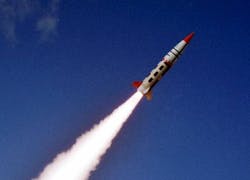Raytheon to help Army develop new long-range artillery rocket for battlefield fire-support
REDSTONE ARSENAL, Ala., 16 March 2016. U.S. Army fire-support experts are choosing Raytheon Co. as one of two or more companies to begin developing a new long-range artillery rocket with a maximum range of 300 miles to replace the Army Tactical Missile System (ATACMS).
The Raytheon Missile Systems segment in Huntsville, Ala., will offer a new missile design for the Army's Long-Range Precision Fires (LRPF) program, Raytheon officials announced today. The Army terminated ATACMS production in 2007.
Raytheon will be one of two or more companies to begin developing an LRPF system that is compatible with launchers for the Army's M270A1 Multiple Launch Rocket System (MLRS) and M142 High Mobility Artillery Rocket System (HIMARS).
Army leaders plan to downselect the LRPF program to one contractor in late 2018 or 2019 for full-scale development, and begin producing the new system by late 2021 or 2022. Lockheed Martin Corp. -- the ATACMS contractor -- and the Boeing Co. reportedly also are interested in the LRPF program.
"Our LRPF design will provide the U.S. Army with double the combat power of its ground launchers by utilizing a new design that fits two missiles in a single launcher pod -- increasing effectiveness at a fraction of the cost of the current weapon," says Thomas Bussing, Raytheon vice president of Advanced Missile Systems.
"Advances in propulsion will enable LRPF to fly faster over longer distances -- approximately 500 kilometers -- to defeat fixed land targets, Bussing said in a Raytheon announcement released today.
The LRPF program is intended to provide battlefield commanders with round-the-clock all-weather long-range fire support without placing aircraft and crews at risk.
Raytheon and any future LRPF contractors will conduct competitive sub-system risk reduction activities to mature the rocket motor and warhead technology. Two or more contractors will build competitive LRPF prototypes through the program's technology maturation and risk reduction phase.
Related: Army surveys industry for affordable proximity sensor for GMLRS and ATACMS missile systems
Army officials are trying to keep their options open on whether to perform a service life extension of the Lockheed Martin ATACMS program, restart the ATACMS production line, develop a new missile to replace ATACMS, and considering systems built by U.S. allies.
The amount of the contract to Raytheon was not released. The Army Contracting Command at Redstone Arsenal, Ala., awarded the contract to Raytheon on behalf of the The Precision Fires Rocket And Missile Systems Project Office of the Army Aviation & Missile Command's Program Executive Office for Missiles And Space.
For more information contact Raytheon Missile Systems online at www.raytheon.com, the Army Contracting Command-Redstone at www.acc.army.mil/contractingcenters/acc-rsa, or the Army Aviation & Missile Command at www.army.mil.

